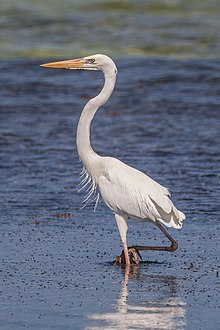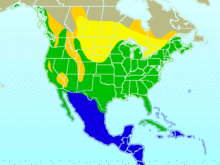Great blue heron
| Great blue heron | |
|---|---|
 |
|
| Dark form | |
 |
|
| White form, A. h. occidentalis both in Cuba |
|
| Scientific classification | |
| Kingdom: | Animalia |
| Phylum: | Chordata |
| Class: | Aves |
| Order: | Pelecaniformes |
| Family: | Ardeidae |
| Genus: | Ardea |
| Species: | A. herodias |
| Binomial name | |
|
Ardea herodias Linnaeus, 1758 |
|
 |
|
| Breeding range Year-round range Wintering range Present during migration | |
The great blue heron (Ardea herodias) is a large wading bird in the heron family Ardeidae, common near the shores of open water and in wetlands over most of North America and Central America, as well as the Caribbean and the Galápagos Islands. It is a rare vagrant to coastal Spain, the Azores, and areas of far southern Europe. An all-white population found only in the Caribbean and Florida was once treated as a separate species and known as the great white heron.
The great blue heron was one of the many species originally described by Carl Linnaeus in his 18th-century work, Systema Naturae. The scientific name comes from Latin ardea, and Ancient Greek erodios, both meaning "heron".
The great blue heron is replaced in the Old World by the very similar grey heron (Ardea cinerea), which differs in being somewhat smaller (90–98 cm (35–39 in)), with a pale gray neck and legs, lacking the browner colors that great blue heron has there. It forms a superspecies with this and also with the cocoi heron from South America, which differs in having more extensive black on the head, and a white breast and neck.
The five subspecies are:
It is the largest North American heron and, among all extant herons, it is surpassed only by the goliath heron (Ardea goliath) and the white-bellied heron (Ardea insignis). It has head-to-tail length of 91–137 cm (36–54 in), a wingspan of 167–201 cm (66–79 in), a height of 115–138 cm (45–54 in), and a weight of 1.82–3.6 kg (4.0–7.9 lb). In British Columbia, adult males averaged 2.48 kg (5.5 lb) and adult females 2.11 kg (4.7 lb). In Nova Scotia and New England, adult herons of both sexes averaged 2.23 kg (4.9 lb), while in Oregon, both sexes averaged 2.09 kg (4.6 lb) Thus, great blue herons are roughly twice as heavy as great egrets (Ardea alba), although only slightly taller than them, but they can weigh about half as much as a large goliath heron. Notable features of great blue herons include slaty (gray with a slight azure blue) flight feathers, red-brown thighs, and a paired red-brown and black stripe up the flanks; the neck is rusty-gray, with black and white streaking down the front; the head is paler, with a nearly white face, and a pair of black or slate plumes runs from just above the eye to the back of the head. The feathers on the lower neck are long and plume-like; it also has plumes on the lower back at the start of the breeding season. The bill is dull yellowish, becoming orange briefly at the start of the breeding season, and the lower legs are gray, also becoming orangey at the start of the breeding season. Immature birds are duller in color, with a dull blackish-gray crown, and the flank pattern is only weakly defined; they have no plumes, and the bill is dull gray-yellow. Among standard measurements, the wing chord is 43–49.2 cm (16.9–19.4 in), the tail is 15.2–19.5 cm (6.0–7.7 in), the culmen is 12.3–15.2 cm (4.8–6.0 in), and the tarsus is 15.7–21 cm (6.2–8.3 in).
...
Wikipedia

